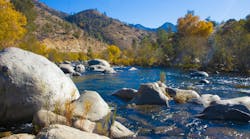
“Beef. It’s what’s for dinner” has long been the slogan of the Cattlemen’s Beef Board and National Cattlemen’s Beef Association. If a new group of entrepreneurs has their way, we might all be eating something cheaper and greener (in every sense) instead.
All across the country, especially in warmer weather, algae becomes a problem in lakes, rivers, and bays, at least partially the result of excess nutrients in stormwater runoff. Algae blooms can destroy an area’s tourism and, in the worst cases, lead to hypoxia and dead zones. But now there’s another way to look at algae—as a food source, although you probably won’t be eating the stuff that’s skimmed off the local lake.
As this article, written by a brave soul who has been experimenting with algae-based nutrition, explains, the average American man eats 100 grams of protein a day, which is about twice what he needs, and much of that is animal-based protein, which is costly to produce. It takes lots of water to grow the feed for the animals—the article notes, “About 70% of the planet’s available fresh water goes toward crops and raising livestock”—and cows produce methane, a greenhouse gas. Algae, on the other hand, also provides protein, and as it grows it consumes carbon dioxide and produces oxygen; half of the oxygen in the world, in fact, comes from some form of algae.
So instead of trying to eradicate algae, as many water-quality managers are doing, or to cut off its nutrients at the source, some people are cultivating it. One company has begun to farm and harvest algae on about a hundred acres of saltwater ponds in New Mexico. “There are hundreds of thousands of strains of algae in the world, and there is a subgroup of those that are stinky and slimy and gross, but there are lots that are not,” a company vice president explains. The particular strain the company, called iWi (formerly Qualitas Health), is growing is nannochloropsis. The protein powder derived from it can be added to a variety of foods without significantly changing the taste. This particular farm has a total of 900 acres available for eventual algae cultivation.
The algae is a source of omega-3 fatty acids. Many people eat fish or take fish oil supplements as a source of omega-3, but the fish, in turn, get it from eating algae (or from eating smaller fish that eat algae); the fatty acids bioaccumulate in their tissues. Harvesting and eating the algae directly, producers say, would “cut out the middlefish” and also reduce the risk of consuming other things, like mercury and PCBs, that also bioaccumulate in fish.
“Made up of 40% protein, [the algae] can produce about seven times the amount of protein as soybeans on the same amount of land,” according to the article.
“There are tons of desert areas all over the world and most of them have brackish water underneath,” says the company’s CEO. “What we are building is 100% sustainable and 100% scalable.”
So what would be a good slogan for algae-based protein?
About the Author
Janice Kaspersen
Janice Kaspersen is the former editor of Erosion Control and Stormwater magazines.

